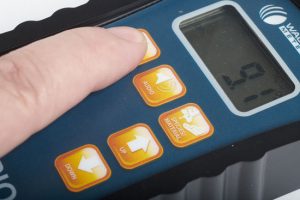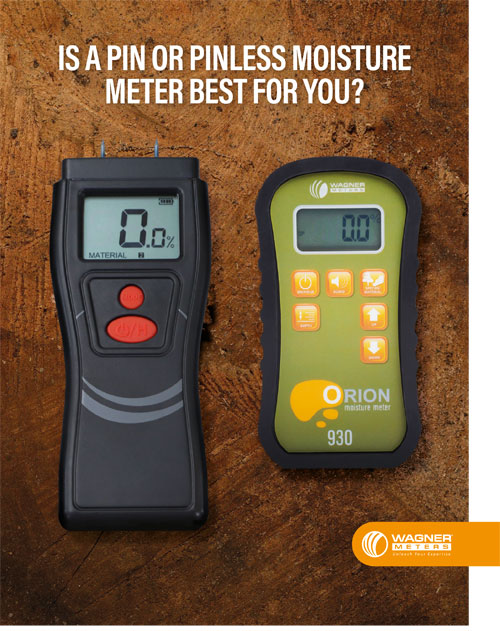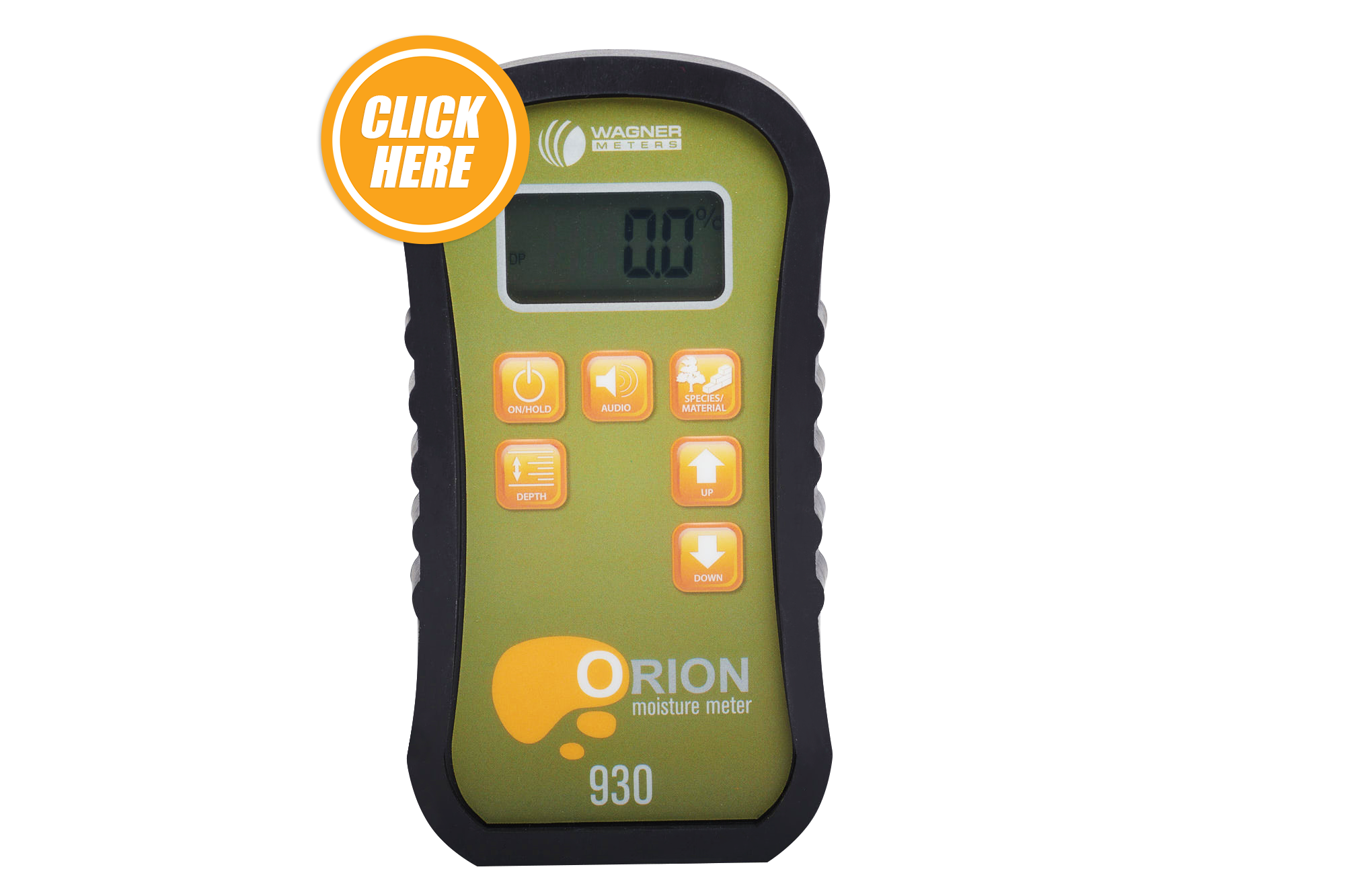What Do These Moisture Meter Readings Mean?
Anyone who works with wood must know its moisture content. The moisture content of wood is defined as the ratio of the weight of the water in the piece of wood to the weight of the piece of wood without the water.

You cannot know if a piece of wood is right for your project unless you know its moisture content. Depending on the type of project and where you live, the required wood moisture content is usually in the 6-12% range.
Why Is Moisture Content Important?
The moisture content of wood is important because the wood will shrink or expand according to its moisture content. In other words, its physical size will change. This has the potential to cause a host of problems.
Imagine spending hundreds of hours building a beautiful wood cabinet only to see it start to deform later. These problems can be easily avoided if you know the wood’s moisture content.
how much does wood shrink or expand?
While the amount of shrinkage or expansion varies from species to species, wood will generally shrink or expand about 1% across the grain when its moisture content changes by 4%. However, even with large moisture changes, wood barely shrinks or expands at all along the grain.
Why is it important for woodworkers to know about moisture content?
You might think that the 1% shrinkage caused by a 4% change in moisture content isn’t that much. However, even a shrinkage this small – maybe only several thousandths of an inch – can cause after-construction gluing problems, especially with cracks and joints. This can happen with furniture, cabinets, or wood flooring.
With furniture or cabinets, a 1% shrinking or swelling can result in poor-fitting drawers, doors, and joints. It can even cause warping and cracks in the finish.
Wood flooring will also shrink or expand with moisture changes; even small changes can produce significant effects.
For example, a small 1/32” change per 2” multiplied across an 8-foot room equals 1 ½”. A change this big will be easy to see.
Know Wood’s Equilibrium Moisture Content
Once wood acclimates to its environment, it reaches its equilibrium moisture content or EMC. This happens when the moisture inside the wood reaches a balance or equilibrium with the relative humidity (RH) and temperature of the wood’s surrounding environment. It stays that way as long as the RH and temperature don’t change.
The air’s RH affects the EMC. Here’s how that works:
If the air’s RH is 40% and the temperature is 68F, the wood will eventually attain an EMC of just under 8%.
Here are some key RH values and the corresponding EMC:
| Relative Humidity (RH) | Temperature | Equilibrium Moisture Content (EMC) |
|---|---|---|
| 30% | 68F | 6.2% |
| 40% | 68F | 7.7% |
| 50% | 68F | 9.3% |
The first two values above are fairly typical interior EMC values for most of North America’s heated and air-conditioned offices and homes. The 50% RH level would be at the higher end of normal interior EMC values.
In cold weather climates, when a heater is running, interior conditions may be even drier than 6% EMC unless the air is humidified.
On the other hand, in humid summer months, especially without air-conditioning, moisture levels in homes, offices, and manufacturing facilities may sometimes exceed 9% EMC.
In most of the U.S., when the wood is outdoors but protected from the rain, the wood will attain an EMC of 12% when the RH is 65%.
The EMC is higher in coastal areas, including parts of Florida, Texas, Louisiana, Washington, and island climates. In these high moisture and more humid locations, wood indoors can reach a 12% EMC, while wood outdoors can attain a 16% EMC.
Wagner Meters’ Orion® 950 Smart Pinless Wood Moisture Meter has a built-in EMC calculator. This makes it easier than ever for professionals to calculate the EMC while they’re on the go.
Managing Wood Moisture
The best way to manage wood moisture content is to use a quality wood moisture meter and conduct a moisture test. Consider it good insurance for anyone involved with woodworking or flooring projects.
According to Dr. Gene Wengert, Professor Emeritus at the University of Wisconsin-Madison, 75% of all wood manufacturing and quality issues are related to moisture content. A quality moisture meter is a perfect tool for spotting wood moisture issues before they become big problems.
What Do Moisture Meter Readings Mean
Moisture meters are used to measure the percentage of water in a given piece of wood and are most useful when the moisture percentage ranges from 5% to no more than 30%. When the moisture content is around 30%, wood reaches its fiber saturation point or FSP.
Moisture meter accuracy is greatly reduced when the wood moisture content is above the fiber saturation point. In fact, above this point, most readings are no longer even useful.
Wood in buildings usually has a 5% to 15% moisture content. The best range of moisture for interior furniture projects is usually 6% to 8% moisture content, with interior softwood millwork tolerating a slightly higher moisture content.
Depending on the type of meter (pin or pinless), either the naturally-occurring chemicals or minerals or the wood’s density can affect the accuracy of the moisture measurements.
How to Read a Moisture Meter
Pin-Type Moisture Meters
Pin-type meters are more sensitive than pinless meters to naturally-occurring chemicals and minerals in the wood and wood temperature variations. A quality pin-type meter should always come with temperature correction charts. These are especially important when conducting moisture tests on wood that hasn’t been stored at room temperature.
Pin-type meters are also sensitive to the wood’s chemical makeup, which varies according to species. Therefore, pin-type meters should require the user to input the wood species before taking a moisture reading.
Pinless Moisture Meters
Pinless meters are more sensitive to differences in wood density (or specific gravity). Since density varies according to wood species, pinless meters require the user to set the meter to the correct average specific gravity before taking a measurement.
Wagner’s pinless moisture meters allow you to set the specific gravity from .20 to 1.0 easily. This range allows you to measure the moisture content of nearly every currently known wood species, including softwoods and temperate and tropical hardwoods.
What’s Your Targeted Wood Moisture Level?
For nearly all interior wood applications (and even some outdoor ones), wood needs to be dried to a moisture content appropriate for the environment where it will ultimately be used. The target moisture content will depend on how the wood will be used and the average RH at the location where the wood will be used.
According to Dr. Gene Wengert, Professor Emeritus at the University of Wisconsin-Madison, wood should be dried to a moisture content that’s within 2 percentage points of the EMC of the location where it will be used. (The EMC of air is equal to the moisture content the wood will attain when stored indefinitely at a particular humidity level. A plus or minus 10-degree variation from normal 70-degree ambient temperature has no significant effect on the EMC.) Targeted moisture content will vary from region to region.
The average RH in most homes and offices in the U.S. — except for coastal regions and dry areas like the desert Southwest — is between 30% and 40%. This means the EMC ranges from 6.2% to 7.7%. In other words, wood in interior locations will equilibrate in this range. Therefore, lumber intended for interior use should be dried to a moisture content of approximately 6% to 8% and kept at this moisture content both before and during manufacturing.

Free Download – Is a Pin or Pinless Moisture Meter Best For You?
Can a Moisture Meter Be Wrong?
Well, a moisture meter can be wrong depending on the type of moisture meter (pin-type or pinless), the quality, and how it’s used. Even the best moisture meters can produce inaccurate readings if the meters aren’t used properly.
You won’t get an accurate reading if your digital moisture meter isn’t calibrated. Therefore, all wood moisture meters must be calibrated before use. All Wagner moisture meters are factory-calibrated and ready to be used.
Accuracy of Pin-Type Moisture Meters
Because pin-type moisture meters are sensitive to variations in temperature, they should always be used with temperature correction charts.
Pin-type moisture meters are also sensitive to the chemical makeup of wood, which varies from species to species. Therefore, all pin-type wood moisture meters should ask the user to input the type of wood before taking a reading.
Failure to account for temperature variations and a wood’s chemical makeup will reduce the accuracy of even the best pin-type moisture meters.
Accuracy of Pinless Moisture Meters
Pinless moisture meters are sensitive to variations in wood density (also known as ‘specific gravity’). Therefore, they need to be set to the proper wood density before taking a moisture reading. Obviously, if the user fails to do this, the reading won’t be accurate.
Wagner’s Orion series of meters are the most accurate wood moisture meters on the market. They allow you to set the wood density to accurately measure every wood species. This includes both tropical and temperate hardwoods as well as softwoods.
What Is a Normal Moisture Reading?
 Furniture, cabinets, wood objects, and other woodwork used indoors typically require a wood moisture reading from 6-8%. However, in high humidity coastal regions or other locations near large bodies of water this range may be extended to 10%.
Furniture, cabinets, wood objects, and other woodwork used indoors typically require a wood moisture reading from 6-8%. However, in high humidity coastal regions or other locations near large bodies of water this range may be extended to 10%.
Wood musical instruments, microphones, bowling pins, and other specialty items made of wood usually require a wood moisture reading of 6-9%.
The moisture content typically ranges from 6-8% for hardwood floors. When installing hardwood floors, check the moisture content of the finished hardwood and the wood subfloor. Depending on the finished hardwood’s width, the hardwood flooring’s moisture content must be within 2-4% of the subfloor moisture level.
The moisture content of lumber used for framing, exterior construction, and exterior furniture usually ranges from 12-19%. Anything above 19% is susceptible to mold and decay.
Final Comment
Remember, wood experts, say that moisture is to blame for at least 75% of all failed wood projects. In other words, the wood was either too wet or too dry.
Whatever the type of wood or project, a quality moisture meter will allow you to ensure that your wood is dried to the correct moisture content level before use.
Our Orion 950 Smart Pinless Wood Moisture Meter is the best in the industry and trusted by professionals. It comes with Bluetooth, an app for your smart device, an RH sensor, and an EMC calculator.
As Sales Manager for Wagner Meters, Ron has more than 35 years of experience with instrumentation and measurement systems in different industries. In previous positions, he has served as Regional Sales Manager, Product and Projects Manager, and Sales Manager for manufacturers involved in measurement instrumentation.
Related Posts via Taxonomies
Last updated on August 9th, 2022




Hi Ron- just purchased a home n PA and had the roof inspected which showed a leak on the plywood directly under the shingles. The reading was 22 percent on the meter. The owners had contractors come out to repair it. Should I be concerned or just keep any eye out?
Mansel, I would just keep an eye out for now.
What do you reccomend if base baords on dry wall have a 23% moisture but have been there 5 years and no signs of decay or visible mold? The dry wall they’re attached to is inside of a stone house shell.
Gareth, I’m not sure that the 23% MC reading is accurate; it sounds pretty high, but nonetheless, it appears as if you don’t have a problem, but if you have concerns about possible mold, I suggest you also contact NORMI, https://www.normi.org and see if they can help you locate a certified inspector near you.
Hi Ron,
My BF moved into a downstairs apartment that is very shaded (2 miles from the beach). For the past couple months, we have smelled musty smells and called out the property manager to check for leaks/mold. He found all the walls and ceilings read at 10-14% on a pin reader. The floors would not read (the are thick laminate). In the bathroom, the ceiling read at 40% moisture. I am extremely worried about this as we also found mold on his wood furniture but not on the walls. Is it possible the 40% moisture is not the cause of the mold or is it the most likely suspect? We want to get someone out with a better reader to test the floors as well.
Kimberly, I highly recommend that you call in a mold testing/inspection company to determine if mold is present. I suggest you also contact NORMI, https://www.normi.org, and see if they can help you locate a certified inspector near you.
Hi Ron,
Great post. We’re building a new home and have a roof leak. Unfortunately, the insulation and drywall had already been installed. We ripped out the wet drywall and insulation and have a fan to dry out the wood. Using a moisture meter with a pin, the previously wet area received a 14% reading. Is it safe to put new insulation and drywall up or does it need to dry out more? The builder has not been helpful in addressing this issue.
Appreciate any thoughts you might have.
Sincerely, Alison
Alison, 14% seems awfully high for drywall. Also, what brand and model of pin meter are you using? Feel free to contact me here at Wagner. We are in Oregon, USA, Pacific Time Zone. 541-582-0541 or from North America, 800-634-9961.
That is a very good tip particularly to those fresh to the blogosphere.
Simple but very precise info… Thanks for sharing this one.
A must read article!
We are replacing an existing shower stall in a home that was new in 2006. The moisture reading of the wall is 12.3. House is wood frame. Should this reading of 12.3 require replacing the existing dry wall before installing a new shower stall?
if a reading of 30% in engineered wood should it be replaced possible mold ?
Harry,
Thanks for writing in. The full saturation point of wood is 32%. That said, I would be curious what meter you are using to get the 30% reading? What is the wood you are measuring? What is the SG setting? What is the thickness of the wood? What is your depth setting?
I can only assume that the floor is installed and you are reading through the wood into the subfloor.
I am happy to assist but some critical questions must be addressed first. Perhaps reach out and contact me directly as your time allows: 1-800-634-9961 ext 212.
Again, thank you for reaching out, we are always here to assist.
What does a reading of 999 mean? Measuring ceiling drywall ( 2 layers, upper and lower) into floor assembly above the ceiling.
Which moisture meter are you using, Barb?
I have a wood floor that is showing 99% m.c.in some areas.Other areas its 40% it’s inconsistent through out the home.Theres no cupping or crowning.However along the exterior walls there is some discoloration.What could be going on here?
Sean:
Thanks for the question. Unfortunately, it’s VERY hard to help you because the meter you are referencing is utilizing a scale that makes no sense in relation to wood moisture content. This is very common in low quality meters. Another issue of these types of meters is their inability to allow the user to “fine tune” meters settings for wood species. This is critical for reproducible, accurate readings. Fiber saturation for wood is in the 30%MC range so scales that go much above that are doing little in reality. Good luck.
Jason
Hi Ron – We need an expert locally to diagnose what went wrong with our bamboo floors. Do you have any recommendations of a local professional we could hire to review the situation and provide an opinion? We are trying to understand what happened & how to prevent it from happening with a new floor. -Mandi in Austin, Texas
Mandi, I recommend you contact the National Wood Flooring Association (NWFA) in St. Louis. They can give you the name of a certified inspector for your area.
Thanks for the very informative post. I am glad to know about these things about moisture meters on this blog.